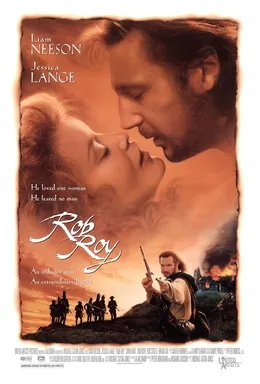Historical accuracy of Rob Roy

Historical accuracy of Rob Roy

Characters
Robert Roy MacGregor
Rob Roy was a real historical figure, a cattleman and Clan Gregor member who became an outlaw. The film captures his legendary status but portrays him with an idealized sense of honor and simplifies the complex historical context of his feuds and activities.
Mary MacGregor
Rob Roy's wife was Mary Helen MacGregor. The film portrays her strength and resilience, consistent with folklore, but specific plot points involving her (like the rape) are fictionalized for the drama.
Archibald Cunningham
Cunningham is an entirely fictional character created for the film to serve as the primary villain and provide a direct antagonist for Rob Roy's personal conflict and the climactic duel.
James Graham, Marquis of Montrose
The 1st Duke of Montrose (previously 4th Marquis) was a real figure with whom Rob Roy had significant financial disputes leading to his outlawry. His portrayal as haughty reflects historical context, but his direct interactions and motivations in the film are dramatized.
Killearn (James Grahame)
Montrose did have a factor named Grahame of Killearn. However, his depiction as a primary conspirator with the fictional Cunningham in the theft plot is dramatic invention.
Alasdair MacGregor
A fictional character representing the loyalty of Rob Roy's clansmen and friends.
More characters
Coll MacGregor
Another fictional member of Rob Roy's band, representing the ordinary Highlanders following him.
John Campbell, Duke of Argyll
Argyll was a real, influential figure who rivaled Montrose. His intervention and offer of protection to Rob Roy reflect historical possibilities rooted in clan politics and his known interactions with Rob Roy later in life.
Betty Sturrock
A fictional character whose suffering serves to highlight Cunningham's villainy.
Guthrie
Likely a fictional character representing the agents who acted on behalf of powerful nobles like Argyll.
Story
Rob Roy as respected MacGregor figure
Rob Roy was a well-known figure within Clan Gregor and the Trossachs region, involved in cattle dealing and seen as a leader.
Rob Roy borrows £1000 from Montrose
Rob Roy did borrow a large sum (around £1000) from Montrose for a cattle venture, which subsequently went missing (though circumstances differ from the film).
Loan money stolen by Killearn/Cunningham
The theft plot involving the fictional Cunningham and a complicit Killearn is dramatic invention. Historically, Rob Roy entrusted the money to his chief drover, who disappeared with it.
Rob Roy declared bankrupt and outlaw
Following the loss of Montrose's money and his inability to repay, Rob Roy was declared bankrupt and outlawed.
Rob Roy's home burned, family persecuted
Montrose did pursue Rob Roy vigorously, evicting his family, burning his house, and seizing his property and cattle.
Mary MacGregor raped by Cunningham
This event is fictional, created to intensify the conflict with the non-historical villain Cunningham and motivate Rob Roy. There is no historical record of Mary being raped.
Rob Roy's campaign against Montrose
As an outlaw, Rob Roy conducted a long feud with Montrose, involving cattle raiding, extortion (demanding 'black mail' or protection money), and evading capture.
Rob Roy's capture(s) and escape(s)
Rob Roy was captured several times during his outlaw years but managed to escape, including famously escaping across a river. The specific circumstances in the film are dramatized.
Archibald Cunningham's personal vendetta
Since Cunningham is fictional, his obsessive pursuit and personal hatred for Rob Roy is entirely fabricated for the movie's plot.
Duke of Argyll grants Rob Roy protection
Rob Roy eventually sought and received protection from the Duke of Argyll, Montrose's rival, playing on clan and political antagonisms.
Final duel between Rob Roy and Cunningham
The climactic duel is fictional, as Cunningham did not exist. Rob Roy's conflict with Montrose ended through political maneuvering, pardon, and old age, not a duel.
Emphasis on honor and integrity
While likely idealized, the film reflects the strong emphasis on personal honor, loyalty, and clan identity prevalent in Highland culture and central to Rob Roy's legend.
Rob Roy receives pardon
Rob Roy MacGregor was eventually pardoned for his crimes in 1725, partly due to his popular image cultivated by Daniel Defoe's fictionalized biography "Highland Rogue".
Portrayal of general hardship in Highlands
The film effectively portrays the challenging economic conditions and social tensions faced by Highlanders in the early 18th century.
Setting
Scottish Highland landscapes
Filmed on location in Scotland, the movie showcases the dramatic and beautiful Highland scenery accurately, forming an essential part of the story's atmosphere.
Early 18th Century timeframe (c. 1713-1722)
The film is set correctly within the historical period of Rob Roy's main conflict with Montrose and outlawry, between the major Jacobite uprisings.
Highland dwellings
The depiction of simple stone and turf houses for ordinary Highlanders contrasts effectively with the aristocratic settings, reflecting the period's architecture.
Aristocratic estates / Lowland settings
Montrose's residence and scenes involving the aristocracy reflect the architecture and style appropriate for wealthy Lowland Scottish nobility of the time.
Costumes (Highland and Lowland)
The costumes appear well-researched, showing belted plaids (early kilts) for Highlanders and the formal attire of the aristocracy and gentry from the early Georgian period.
Weaponry (Swords, dirks, firearms)
The use of basket-hilted broadswords, dirks, targes (shields), flintlock pistols, and muskets is appropriate for personal combat and skirmishes in the period depicted.
Depiction of Clan system / Social hierarchy
The film reflects the importance of clan loyalty, the power of chieftains (like Argyll and Montrose), and the social divisions between Highlanders and the ruling Lowland elite.
Atmosphere of tension and hardship
The film effectively conveys the precariousness of life, the harsh environment, and the political/economic tensions present in the Scottish Highlands at the time.
Cattle driving / economy
The importance of cattle as a source of wealth and the practice of cattle driving, central to Rob Roy's livelihood and dispute, is accurately portrayed as part of the economy.
